March 31st, 2010 ~ by admin
I’ve posted a fair amount about ARM processors, as today, they are in about everything. That was not always the case. ARM began with a small British company called Acorn Computers, who made various computers such as the BBC Micro (6502 based). They began developing a RISC processor in 1983 with their silicon partner VLSI. We recently received a few early versions of the ARM so here they are, with a brief history.
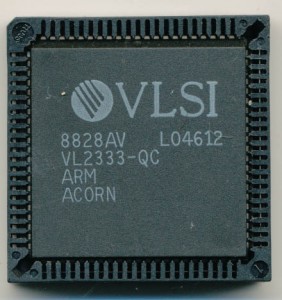
VLSI VL2333-QC 8MHz ARM1 CPU circa 1988
By 1985 they had the first working silicon of the ARM1 processor, a full 32bit design. It had around 25,000 transistors (compared with the earlier Motorola 68000 which had 70,000) so was relatively cheaper.
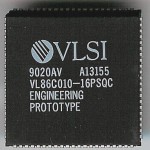
VLSI VL86C010-16PSQC 16MHz ARM2 CPU circa 1990 - Prototype
The next year the released the ARM2 processor, which added a hardware multiply instruction and ran at 8MHz. It had around 30,000 transistors.
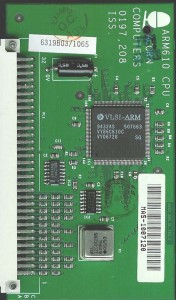
VLSI VY86C610C 30MHz ARM610 CPU circa 1994
In 1994 the ARM6 was released with higher clocks (up to 60MHz) and more features. The rest as we say is history, with many many varieties of cores available, at speeds over 1GHz, but STILL very small footprints. The ARM cores are licenses to hundreds of companies worldwide, and used in millions of devices, and it all began almost 30 years ago.
February 13th, 2010 ~ by admin
The new server runs IIS7, which has rewrite built in. there was an issue with this, permalink (WordPress) and some old IE6 support in the CSS file, this caused the site to not work correctly in all versions of IE.
We apologize for the down time.
February 6th, 2010 ~ by admin
The old server was getting a bit long in the tooth (an old Athlon 64 X2 4200+, 2.2GHz 1MB L2 cache) so we have transitioned The CPU SHack to a new and better server. It is an Intel Core 2 Duo E8400 3GHz dual core CPU with 6MB of L2 cache.
It should be a bit speedier.
January 14th, 2010 ~ by admin
EETimes has another article about a person being charged/convicted of selling counterfeit chips to the US navy. This has been a growing problem in the electronics industry for the last decade, but has its roots much earlier then that.
It was common in the 90’s for counterfeiters (aka remarkers) to take a processor, wipe the markings, and mark it with a higher speed. This was rather common with the Pentium era and newer, but occurred with 486’s as well. To a computer user this typically meant that their computer ran much warmer, and often times less stable.
To a collector this means you must be VERY careful when looking at processors in your museum to ensure that rare sample you have, is not in fact a clever forgery, or that Pentium 133 is not in fact a remarked 75.
Having your computer crash or having a few fake CPUs in your collection is a mere annoyance, but what about actual use? For example a part listed as mil-spec, with a wide temperature operating band, that controls a ships defensive systems? If this is in fact a fake (remarked from a commercial spec IC, which has been happening). The system could and likely WILL fail at the worst time. The result? People lose their lives.
May 3rd, 2009 ~ by admin
IEEE Sprectrum has a neat article detailing 25 microchips that fundamentally changed the IC business (or could have). Some of them are as simple as the 555 timer chips, whose 23 transistors were used, and continue to be used in millions of projects. Some of the processors that made the list are the MOS 6502, Intel 8088 (of course) as well as the SPARC, and Acorn ARM.
April 6th, 2009 ~ by admin
A quake struck Italy last night killing around 100. The CPU Shack Museum wishes the best for all involved. There are many great CPU collectors in Italy and we hope that them, their friends, and families are all OK. If there are any needs, feel free to contact us, and we will attempt to help where we can.
March 27th, 2009 ~ by admin
I recently was surfing eBay and found some Sony microcontrollers, while looking over the datasheet, I noticed the package looked very familiar, a stacked MCU, over a LCC EPROM. I have a similar device in the museum.
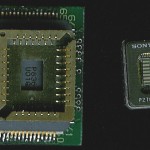
Sony CXP83601
I had not been able to previously identify it as all it said was P836U01, once I added the ‘CX’ in front, it all made sense, and I found its datasheet (albeit in Japanese) its a 10MHz 8bit SPC700 MCU w/ LCD controls and the EPROM is a highspeed 27512 type device (CXP27C7001)
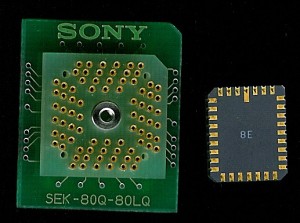
Sony CXP83601
March 18th, 2009 ~ by admin
If you haven’t noticed, we haven’t added new CPU’s to the museum in sometime. Not to fear, we have been getting LOTS more. It just became a huge time killer to upload and add them. Currently we have the programmers building a whole new database system for easily managing all the chips in the museum.
How many processors do we have that need added to the site? Over 1500. Enjoy
January 12th, 2009 ~ by admin
In my daily hunt for new processors, and other chips for the museum, as well as information about new chips, I constantly come across interesting chips, in strange locations. Here you will get a chance to learn WHERE many of the chips in the museum come from and what they are.
Now Available for sale is The Collector’s Guide to Vintage Intel Microchips, Buy it today at the CPU Shack Museum.






